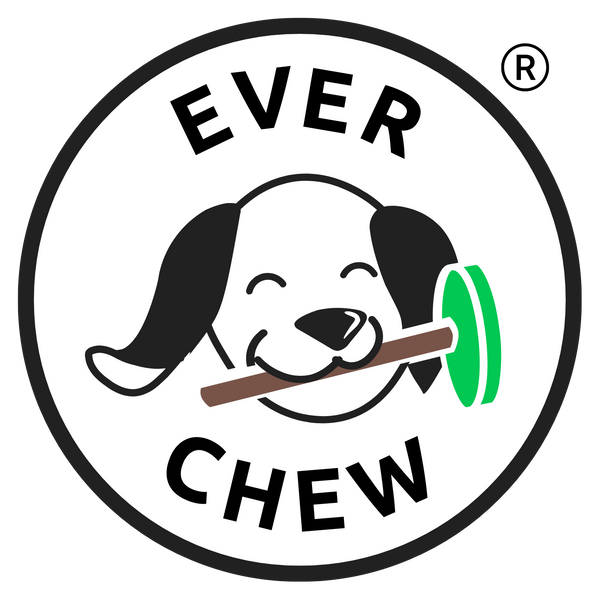Maintenance of the EverChew Holder's Pin

Here's a summary and links to instructional videos about taking care of your EverChew holder's locking pin. There's 3 topics we cover:
- Pin lubrication
- Stuck pins
- Pins with rough heads
Pin lubrication
The EverChew bully stick holder has a locking pin that needs lubrication as maintenance. The pin holds in a bully stick so your dog can't choke on the chew stub. Video walks through lube options.
Transcript:
Kirby with EverChew here wanting to talk about how to lubricate your pins so that they go into the holder better. After a fair amount of use or when some people wash them in the dishwasher (I know Jessica does), the pin won't go in very easily past the latch. It kind of has some restriction on the head and if I bounce it a little I can get it to go past, but it's just not smooth.
And so what we find, in the shop use a food grade silicone. You can use any sort of oil. That's way too much. It takes just a dab. And we use vegetable oil or olive oil will work. The best food oil that we found is coconut oil. It seems to last the longest time on the on the pin itself--I think it it doesn't soak into the plastic as quickly or rub off as well. But you simply put that on and that slides in just like butter. And so that's how you can lubricate your pins so that they go in easier and just pop right in with very little effort. That just goes right in. And there you go. Thank you.
Stuck pins
EverChew's holder locks in bully sticks with a pin to prevent choking, but sometimes the pin itself seems locked. What actually happens is a dried blend of bull pizzle and dog saliva glues the pin to the holder. It's easy to get free by knocking out or wetting, but you'll need to clean the pin up some.
Transcript:
Hey y'all. I want to talk briefly about one of the issues we've seen with the EverChew holders. And you can see how the mechanism works. We have the pin. It goes through two slots in the ring in this cross-section. The pin swings out. Actually, the pin doesn't go that way. It actually goes that way and stays in the cavity when it slides. But you can see this pin needs to slide in and out.
And one thing I've noticed is that sometimes if I let the dogs chew on the ring and then I don't pick it up and the goop that's in there dries, what you'll see is that this is almost impossible to push out. And so I kind of just jam something in there and force it out. I've also tested it and it works to just let it soak real quick and it doesn't take very long and then the pin will push out.
But what you have is you kind of end up sometimes, this is a really bad case, is a pin with this nasty stuff on it, which is essentially dried bully stick residue mixed with dried dog spit. So, it's kind of nasty if you think about it, but just don't think about it. And what you can do is you can kind of scrape it off. But the easy thing to do is just soak this if you want to. It'll wash off. You can see here I'm just able to kind of pull it off. There's a tasty treat. Good night. But it's pretty easy to clean off. So yes, if ever at the end of a chew session you have a tough time getting the pin out, this residue glue may be the problem that you're facing. And so just clean it up and it'll go away. Thank you.
Pins with rough heads
EverChew's holder prevents dogs from choking on bully sticks. But it get's very hard to reload when the pin won't slide back past the latch even when lubricated. For a while my doggo would gnaw in a way that bent in the edges of the pin head. So I found I needed to sand the edge of the pin head so that it wouldn't catch on the latch duing insertion.
Transcript:
Okay, so I’ve got a Super Chew here that my dog Wally has been going hard on for quite a while. You can see it’s very well loved and has taken some abrasion. I noticed something interesting with it about the pin that I wanted to cover. If I take the pin out, he’s somehow been getting his teeth up and it’s created a small lip on the side of the pin that makes it hard to insert. (sanding the lip off).
I can lubricate it, which helps it slide past the latch. Just a pro tip—if your dog is doing the same sort of thing, it might be because their chew style has changed over time. I’ve smoothed out the pin so there’s no more lip, but it’s very dry right now, so it still gets caught and doesn’t want to push in easily. (finish sanding)
There’s no more lip, but dryness makes it stick. I usually use a bit of lubricant—we use food-grade silicone to lubricate them—but if I don’t have that, I can use a cooking oil. If needed, I can even just wet my finger and get the head of the pin damp so it slides right past without needing oil. That’s a quick fix if I’m at home and don’t want to grab lubricant. So that’s how you can smooth out your pin if your dog is doing what Wally is doing and roughening the head of the pin. Of course, we have replacement pins on the website if it’s too far gone. Bye now.
